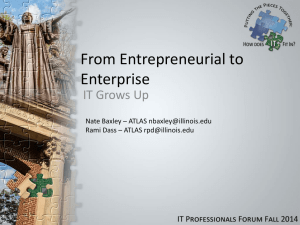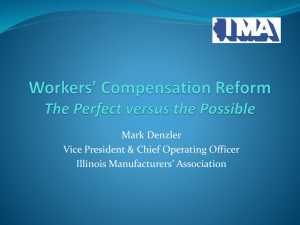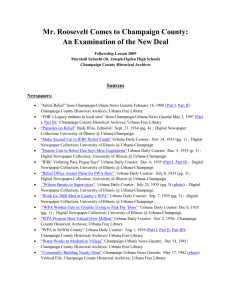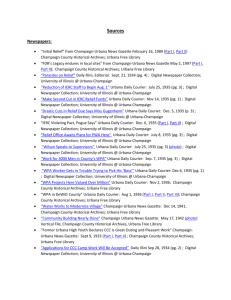Lab Policy
advertisement
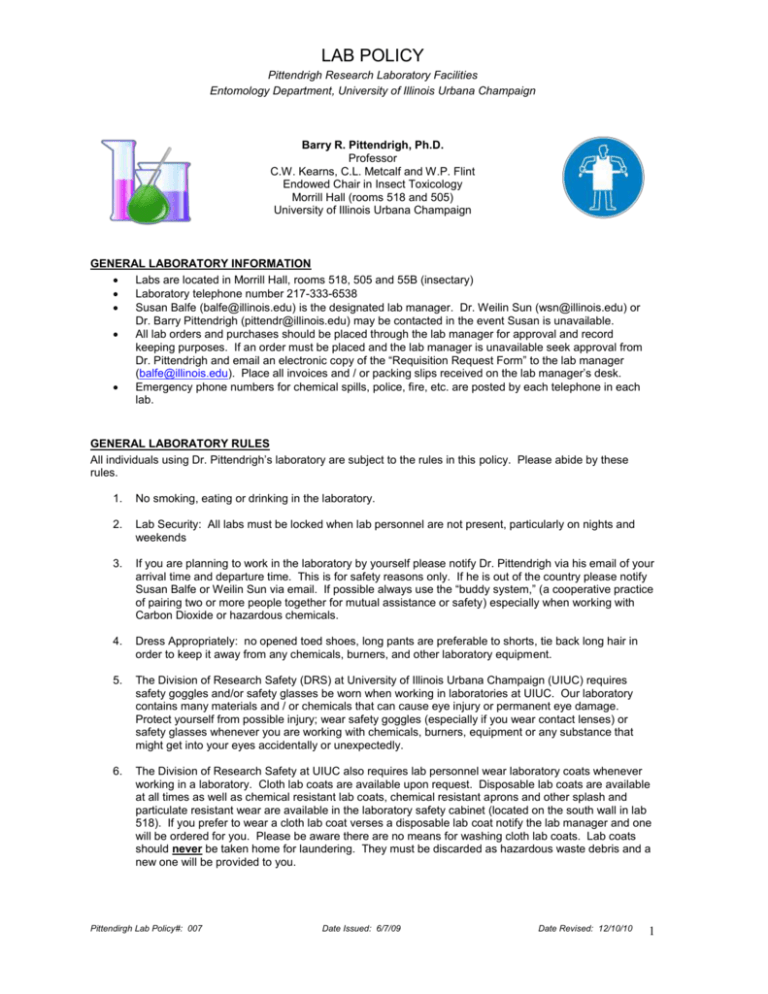
LAB POLICY Pittendrigh Research Laboratory Facilities Entomology Department, University of Illinois Urbana Champaign Barry R. Pittendrigh, Ph.D. Professor C.W. Kearns, C.L. Metcalf and W.P. Flint Endowed Chair in Insect Toxicology Morrill Hall (rooms 518 and 505) University of Illinois Urbana Champaign GENERAL LABORATORY INFORMATION Labs are located in Morrill Hall, rooms 518, 505 and 55B (insectary) Laboratory telephone number 217-333-6538 Susan Balfe (balfe@illinois.edu) is the designated lab manager. Dr. Weilin Sun (wsn@illinois.edu) or Dr. Barry Pittendrigh (pittendr@illinois.edu) may be contacted in the event Susan is unavailable. All lab orders and purchases should be placed through the lab manager for approval and record keeping purposes. If an order must be placed and the lab manager is unavailable seek approval from Dr. Pittendrigh and email an electronic copy of the “Requisition Request Form” to the lab manager (balfe@illinois.edu). Place all invoices and / or packing slips received on the lab manager’s desk. Emergency phone numbers for chemical spills, police, fire, etc. are posted by each telephone in each lab. GENERAL LABORATORY RULES All individuals using Dr. Pittendrigh’s laboratory are subject to the rules in this policy. Please abide by these rules. 1. No smoking, eating or drinking in the laboratory. 2. Lab Security: All labs must be locked when lab personnel are not present, particularly on nights and weekends 3. If you are planning to work in the laboratory by yourself please notify Dr. Pittendrigh via his email of your arrival time and departure time. This is for safety reasons only. If he is out of the country please notify Susan Balfe or Weilin Sun via email. If possible always use the “buddy system,” (a cooperative practice of pairing two or more people together for mutual assistance or safety) especially when working with Carbon Dioxide or hazardous chemicals. 4. Dress Appropriately: no opened toed shoes, long pants are preferable to shorts, tie back long hair in order to keep it away from any chemicals, burners, and other laboratory equipment. 5. The Division of Research Safety (DRS) at University of Illinois Urbana Champaign (UIUC) requires safety goggles and/or safety glasses be worn when working in laboratories at UIUC. Our laboratory contains many materials and / or chemicals that can cause eye injury or permanent eye damage. Protect yourself from possible injury; wear safety goggles (especially if you wear contact lenses) or safety glasses whenever you are working with chemicals, burners, equipment or any substance that might get into your eyes accidentally or unexpectedly. 6. The Division of Research Safety at UIUC also requires lab personnel wear laboratory coats whenever working in a laboratory. Cloth lab coats are available upon request. Disposable lab coats are available at all times as well as chemical resistant lab coats, chemical resistant aprons and other splash and particulate resistant wear are available in the laboratory safety cabinet (located on the south wall in lab 518). If you prefer to wear a cloth lab coat verses a disposable lab coat notify the lab manager and one will be ordered for you. Please be aware there are no means for washing cloth lab coats. Lab coats should never be taken home for laundering. They must be discarded as hazardous waste debris and a new one will be provided to you. Pittendirgh Lab Policy#: 007 Date Issued: 6/7/09 Date Revised: 12/10/10 1 LAB POLICY Pittendrigh Research Laboratory Facilities Entomology Department, University of Illinois Urbana Champaign 7. Follow appropriate waste disposal guidelines. Contact the Division of Research Safety (217) 333-2755 at the University of Illinois Urbana Champaign if you have any questions regarding proper disposal of a chemical, unknown substance, biohazardous material, sharp, etc. 8. General Guidelines for hand protection and glove use; 1) Wear appropriate gloves when the potential for contact with hazardous materials exists (refer to DRS website for further information on glove selection), 2) Reusable Gloves should be rinsed with soap and water and then carefully removed after use. Discard disposable gloves after each use and whenever they become contaminated. 3) Due to potential chemical contamination, which may not always be visible, remember to remove gloves before leaving the laboratory (i.e. no gloves are to be worn in the hallways). Do not wear gloves while performing common tasks such as answering the phone, grabbing a door handle, using an elevator, etc. 9. Each chemical listed in the laboratory chemical inventory must have a Material Safety Data Sheet (MSDS). Take the time to read the MSDS sheet for the chemicals you plan to work with (prior to working with the chemical) and follow the safety recommendations put forth, such as, personal protective equipment, chronic or acute health concerns, respiratory requirements, proper disposal of the chemical and / or material, reactivity concerns, etc. 10. Read Chemical Safety Information: Hard copies of Material Safety Data Sheets (MSDS) are available for each lab. The location for MSDS’s is Morril Hall 518, South Wall, first shelf, left hand side. Addional lab locations are room 505A, east wall, first shelf, left hand side. Location for room 505 Eithidium Bromide Gel Room, pocket sleeve on door front entrance to the gel room. A complete chemical inventory, access to MSDS sheets, resources, student information, policies and procedures is also available on Dr. Pittendrigh’s website located at the following web address, https://sib.illinois.edu/pittendrigh/. In order to access the above mentioned information you will need to go to the “private” section on his website. To locate this section of the website, scroll to the bottom of the homepage, find in very small print close to the bottom of the page the word "login," click on the word login and enter your UIUC life science username and password. If you have any trouble logging in, feel free to contact Pat Mulrooney (computer technical support specialist) at <mulroony@life.illinois.edu>. 11. Standard Operating Procedures (SOP) are in place (currently updating SOP’s and initiating new SOP’s) and must be followed when performing specific laboratory procedures particularly hazardous lab procedures. SOP’s allow us to achieve maximum safety and efficiency of the performed research as well as provide suggested safety guidelines. SOP’s are located in the notebook with the Chemical Hygiene Plan (south wall, first shelf, left hand side, room 518) and may also be found on the website. 12. Identify Lab Safety Equipment: Lab users must become familiar with the location and operation of the fire extinguishers, emergency spill kits, personal protective equipment, fume hoods, eye washes, safety showers, first aid kits and emergency exits. Contact the lab manager if you are not familiar with the location and use of the above mentioned safety equipment. 13. Never Pipette by mouth and don't taste or sniff chemicals. 14. Do Not wear any type of laboratory glove in the hallway. 15. Never reuse latex or Nitrile laboratory rubber gloves. 16. Always remove any gloves you are wearing and wash your hands before leaving the laboratory. 17. In the unlikely event that you are injured at work, take care of yourself first. Then report any on the job injury to the Lab Manager and the Principle Investigator (Dr. Pittendrigh) as soon as possible (see further information below Lab Emergency / Spills) 18. Accidents can and do happen. Prevention is our first line of defense. Before using laboratory equipment consult the lab manager or Dr. Weilin Sun for instructions on the proper use of the equipment. Laboratory equipment can be dangerous and complicated to use, as well as be very costly to replace. Prevent accidents from happening and avoid damage to equipment, get proper training prior to using any lab equipment (see Laboratory Equipment below). Pittendirgh Lab Policy#: 007 Date Issued: 6/7/09 Date Revised: 12/10/10 2 LAB POLICY Pittendrigh Research Laboratory Facilities Entomology Department, University of Illinois Urbana Champaign 19. TAKE SAFETY SERIOUSLY! SAFETY is a top priority in Dr. Pittendrigh’s laboratories. Don't learn safety rules simply by accident! BE ALERT – ACCIDENTS HURT! 20. Please refer to the DRS UIUC Chemical Safety Guide for further information regarding lab safety. A copy of this guide is located in lab 518 or may be accessed via the DRS website, http://www.drs.illinois.edu/css/guidesplans/safety/index.aspx 21. Last, but not least……Please Be GREEN! Please make an effort to turn off lights and equipment that are not in use. LAB SAFETY TRAINING As new or continuing members of the Pittendrigh lab, you will be required to take laboratory safety training courses. Continuing lab members should repeat this training every three years, and new members should complete this training upon hire and before beginning any work in the laboratory. The University of Illinois Urbana Champaign has a “Division of Research Safety” (DRS) which puts forth safety training for all students, faculty and staff as well as waste disposal and answering any questions or concerns you may have regarding research safety. The DRS website homepage is: http://www.drs.illinois.edu/ Click on “Safety Training.” Dr. Pittendrigh’s lab requires you to complete the following safety training: 1. General Lab Safety Training 2. Chemical Management for Laboratories - Part 1, Introduction 3. Chemical Management for Laboratories - Part 2, Hazard Awareness (MSDS) 4. Chemical Management for Laboratories - Part 3, Engineering Controls 5. Chemical Management for Laboratories - Part 4, Work Practices 6. Chemical Management for Laboratories - Part 5, Personal Protective Equipment 7. Chemical Management for Laboratories - Part 6, Emergency Planning 8. Chemical Waste Requirements Training 9. Understanding Biosafety 10. Awareness Training for the Transportation of Hazardous Materials Notify the lab manager as soon as you have completed all the above required safety training. Please email the lab manager (Susan Balfe balfe@illinois.edu ) your “completion certificates,” in pdf format, so they can be entered into the laboratory registry. Once online training is complete the lab manager will provide “Lab Orientation Training.” Standard operating procedures, waste disposal and common use area locations will be defined. Freezer space will be assigned at this time. Additional training may be necessary (e.g. Biosafety Level 1 handling specific to our lab, Arthropod containment Level II training). This is dependent on your project assignment and will be discussed with Dr. Pittendrigh or the Lab Manager. Please see that all training has been completed before you begin work in the lab. RESPIRATORY PROTECTION PROGRAM The Pittendrigh laboratory wants to provide a safe and healthful work environment for its employees and students. Aside from using pre-engineered devices for personal protection from chemical hazards in the laboratory (i.e. a fume hood) Dr. Pittendrigh’s lab offers you the option of joining the University of Illinois Urbana Champaign “Respiratory Protection Program.” Respiratory protection is provided to employees and students to reduce exposure limits to concentrations of chemical hazards, acute or chronic. You are welcome to sign up for this program and be fitted, by a professional, for a respirator at no cost to you. Dr. Pittendrigh will cover the full cost of this program for you as Pittendirgh Lab Policy#: 007 Date Issued: 6/7/09 Date Revised: 12/10/10 3 LAB POLICY Pittendrigh Research Laboratory Facilities Entomology Department, University of Illinois Urbana Champaign well as the purchase of a fitted respirator. Please be sure to read the universities policy regarding this program at the following website. http://safetyandcompliance.fs.illinois.edu/esh_rp.html A physical exam and a respirator fit test will be required to join the “Respirator Protecton Program.” It is lab policy that if you work with DDT pesticide you must join the respiratory protection program and use a fitted respirator. Contact Susan Balfe, Lab Manager, Pittendrigh lab, balfe@illinois.edu, if you chose this option. If you decide not to join the “Respiratory Protection Program.” and prefer to wear a disposable or paper mask [“Voluntary usage of a filter face respirator (i.e., paper mask)] you may do so. If you chose the latter option you must give written confirmation that you are opting out of the “Respiratory Protection Program” and that you prefer to wear disposable or paper masks for protection. Please email the written confirmation that you are opting out of the “Respiratory Protection Program” to Susan Balfe (Lab Manager) and Dr. Pittendrigh (Principle Investigator). BIOSAFETY AND ARTHROPOD CONTAINMENT Levels for Pittendrigh Labs Dr. Pittendrigh’s laboratories (Morrill Hall room 518, room 505, and room 55B) have been designated with the following containment levels: I) Biosafety Level 1 (BSL-1) containment II) Use of Recombinant DNA (NIH Guidelines) III) Arthropod Containment Level-2 (ACL-2) IV) Containment Guidelines for Nonindigenous, Phytophagous Arthropods and Their Parasitoids and Predators These containment levels have been issued by the University of Illinois Urbana Champaign’s (UIUC) Institutional Biosafety Committee (IBC) as well as the United States Department of Agriculture (USDA) Animal Plant Health Inspection Service (APHIS) and must be followed. *Our specific containment restriction concerns are for transgenic insects, the use of bacteria, and recombinant DNA (rDNA). DEFINITION I) BIOSAFETY LEVEL 1 CONTAINMENT is suitable for work involving well-characterized agents not known to consistently cause disease in healthy adult humans, and of minimal potential hazard to laboratory personnel and the environment. The purpose of containment is to reduce or eliminate exposure of laboratory workers, other persons, and the outside environment to potentially hazardous agents. BIOSAFETY LEVEL 1 Standard Practices apply to Dr. Pittendrigh’s labs Standard Microbiological Practices 1. Access to the laboratory is limited or restricted at the discretion of the laboratory director when experiments or work with cultures and specimens are in progress. 2. Persons wash their hands after they handle viable materials, after removing gloves, and before leaving the laboratory. 3. Eating, drinking, smoking, handling contact lenses, applying cosmetics, and storing food for human use are not permitted in the work areas. Persons who wear contact lenses in laboratories should also wear goggles or a face shield. Food is stored outside the work area in cabinets or refrigerators designated and used for this purpose only. 4. Mouth pipetting is prohibited; mechanical pipetting devices are used. 5. Policies for the safe handling of sharps are followed. 6. All procedures are performed carefully to minimize the creation of splashes or aerosols. 7. Work surfaces are decontaminated at least once a day and after any spill of viable material. Pittendirgh Lab Policy#: 007 Date Issued: 6/7/09 Date Revised: 12/10/10 4 LAB POLICY Pittendrigh Research Laboratory Facilities Entomology Department, University of Illinois Urbana Champaign 8. All cultures, stocks, and other regulated wastes are decontaminated before disposal by an approved decontamination method such as autoclaving. Materials to be decontaminated outside of the immediate laboratory are to be placed in a durable, leakproof container and closed for transport from the laboratory. 9. An insect containment and control program is in effect and must be renewed with IBC at UIUC. A version of the Biosafety in Microbiological and Biomedical Laboratories (BMBL) 5th Edition http://www.cdc.gov/biosafety/publications/bmbl5/index.htm Please read and follow all Biosafety guidelines for a level 1 Biosafety designation II) USE OF RECOMBINANT DNA (rDNA) Our laboratory projects do include work with recombinant DNA. All lab personnel must comply with the responsibilities outlined for the Principal Investigator in Section IV-B-7 of the NIH Guidelines. Note that Section IV-B-7-a-(3) states, University policy requires that significant research-related incidents be reported immediately to the Institutional Biosafety Committee via the Biological Safety Section (BSS) of the Division of Research Safety. Such incidents include research-related accidents and illnesses as well as inadvertent release or improper disposal of biohazardous or recombinant DNA materials. BSS can be contacted at 333-2755 and ibc@uiuc.edu. In addition, incidents involving recombinant DNA materials must be reported to NIH/OBA within 30 days by the Principal Investigator. Reports to NIH/OBA shall be sent to the Office of Biotechnology Activities, National Institutes of Health, 6705 Rockledge Drive, Suite 750, MSC 7985, Bethesda, MD 20892-7985 (20817 for non-USPS mail), 301-496-9838, 301-496-9839 (fax). A version of the NIH Guidelines is available online at: http://oba.od.nih.gov/rdna/nih_guidelines_oba.html Please read and follow all NIH guidelines for use of rDNA III) ARTHROPOD CONTAINMENT LEVEL 2 (ACL-2): Our Laboratory has been designated an ACL-2 level of containment by the University of Illinois Urbana Champaign Institutional Biosafety Committee. We must follow all ACL-2 guidelines and procedures put forth by The American Committee of Medical Entomology of the American Society of Tropical Medicine and Hygiene A version of “The Arthropod Containment Guidelines” manual can be found on line at http://www.astmh.org/acme.htm#ACG Please read and follow all Arthropod Containment Guideline (ACL-2) IV) CONTAINMENT GUIDELINES FOR NONINDIGENOUS PHYTOPHAGOUS ARTHROPODS AND THEIR PARASITOIDS AND PREDATORS is an inspection process put forth by USDA APHIS PPQ to prevent the release of nonindigenous plant pests to the environment of the United States. Accidental or purposeful release of these organisms is a violation of the FEDERAL PLANT PEST ACT and is subject to civil and/or criminal penalties and loss of permits. Field collections of these organisms may be contaminated with described and undescribed organisms such as plants, hyperparasites, plant pathogens, entopathogens, arthropods, etc. During inspections or re-inspections of your facility, USDA, APHIS, PPQ personnel will review these guidelines and any risk mitigation instructions that may accompany your permit. When your facility meets containment standards and risk mitigation instructions, USDA, APHIS, PPQ will issue a letter of eligibility for your facility. You may then apply for appropriate permits. Training is required before handling USDA APHIS Regulated Arthropods, this would include the cowpea weevil Callosobruchus species for Dr. Pittendrigh’s lab. A version of the Containment Guidelines for Nonindigenous Phytophagous Arthropods and their Parasitoids and Predators is available online at: Pittendirgh Lab Policy#: 007 Date Issued: 6/7/09 Date Revised: 12/10/10 5 LAB POLICY Pittendrigh Research Laboratory Facilities Entomology Department, University of Illinois Urbana Champaign http://www.aphis.usda.gov/plant_health/permits/organism/containment_facility_inspections.shtml http://www.aphis.usda.gov/plant_health/permits/downloads/arthropod_biocontrol_containment_guidelines.pdf Please read and follow all Containment Guidelines TRANSPORT OF BIOHAZARDOUS MATERIALS, TRANSGENIC AND QUARANTINED ARTHROPODS Biohazardous materials are not to be removed from any of the Dr. Pittendrigh’s labs without permission from the Dr. Pittendrigh, the lab manager or UIUC’s IBC. This would include transgenic insects, bacteria cell cultures, and recombinant DNA. If biohazardous materials are granted permission to be transported by laboratory personnel, they must be contained in such a way as to prevent release to the environment in case of an accident (e.g., placed in a primary container that is securely closed, a watertight tube, vial or ampoule, which is then placed in an unbreakable, watertight secondary container that is labeled with the international biohazard symbol. Enough absorbent material, such as paper towels, must be placed in the space at the top, bottom, and sides between the primary and secondary containers to absorb the entire contents of the primary container in case of breakage or leakage). For intra-facility transport, use of a cart to facilitate transport is recommended. Appropriate personal protective equipment (PPE) and clean-up materials should be kept in the transport vehicle or on the cart used to transport the material. If a spill occurs during transport, do not attempt to clean it up without appropriate spill response material and PPE. Keep other persons clear of the spill. LAB STORAGE SPACE (Freezers and Refrigerators) All laboratory personnel create and construct samples, request orders for kits and chemicals, as well as make solutions. All of these items need to be labeled, dated, inventoried and stored. Storage locations range from -80 freezers to -20 freezers, to refrigerators, to bench tops and lab shelves. With the large number of materials generated and/or materials purchased, it is beyond the scope for lab manager to manage and inventory every item. Therefore, all lab personnel are required to place the following information on all materials they have requested be ordered or samples they have created. 1) 2) 3) 4) Name (initials are okay when writing space is limited). Date sample was created or date item was received Expiration Date, if possible Detailed information about the sample or solution Example of labeling for a sample of “RNA from Maruca vitrata, Susan Balfe, prepared 5/7/10.” Example of labeling for a solution of ETOH, 70% Ethyl Alcohol, 30% DiH2O = 100% solution SB 11/23/10 Example for a chemical with manufacturers label: Date received, Pittendrigh Lab, Location Key (e.g. WW_S1) see chemical inventory It is understood that there are cases where there is not enough room on the sample tube or solution bottle to write the requested labeling information or there may be an excess number of samples (e.g 100, 1.5ml micro tubes). If this is the case, the person responsible for the samples must fill out a separate inventory sheet. A number or letter can be established and written on the sample tube to correspond to the individuals inventory sheet. A standardized inventory sheet is available from the lab manager for this purpose (you may request this via email). Colored cryo labels and tags are available for laser printing. Please email the completed and / or updated personal inventory sheets to the lab manager whenever possible. Beginning in the year 2010 all Pittendrigh freezers and refrigerators will be defrosted and cleaned out at the end of each spring semester. If samples or solutions are not labeled in any way and remain in freezers and refrigerators they will be discarded at the end of the annual spring semester cleaning. Pittendirgh Lab Policy#: 007 Date Issued: 6/7/09 Date Revised: 12/10/10 6 LAB POLICY Pittendrigh Research Laboratory Facilities Entomology Department, University of Illinois Urbana Champaign Upon completion of your research in the Pittendrigh lab, each member of the lab is responsible for cleaning out and disposing of unwanted samples to make room for new incoming students. Some samples may need to be archived for future use others may need to be disposed of through UIUC DRS waste disposal. Freezers and refrigerators have assigned shelving. If you need a shelf assignment please notify the lab manager. LAB EMERGENCY SPILLS There are Chemical Spill Kits located in both of Dr. Pittendrigh’s Labs (room 518 Located under the sink on the east most side of the lab, room 505A located under the sink on the east wall). Staff should familiarize themselves with the Spill Kit contents and use. First aid kits are located near safety showers in each lab (rooms 518 and 505A). Follow emergency spill procedures located in the Chemical Hygiene Plan and on the DRS website, http://www.drs.illinois.edu/. Emergency telephone numbers are posted by each telephone. Any accidents or spills should be reported to Dr. Barry Pittendrigh, Susan Balfe or the Entomology main office. MATERIAL SAFETY DATA SHEETS (MSDS) Each lab, Morrill Hall room 518 and room 505, has a chemical inventory with copies of Materials Safety Data Sheets (MSDS) for chemicals used in these labs. For every purchased / known chemical in the laboratory there will be a Material Safety Data Sheet (MSDS) available. MSDS sheets may also be located on Dr. Pittendrigh’s “Private” website listed above. Before handling or working with any chemical in the laboratory please read and understand the hazards associated with using the chemical. The lab manager is responsible for ordering and maintaining the lab chemical inventory and MSDS sheets. If you have any questions feel free to contact the lab manger or the UIUC Division of Research Safety (217-333-2755). Please notify the lab manager immediately if an MSDS is missing! MSDS sheets can be obtained quickly from the web, if necessary. Location of MSDS’s 1) Morrill Hall room 518, South wall, first shelf, left hand side. 2) Morrill Hall room 505A, East wall, first shelf, left hand side. 3) Morrill Hall Gel documentation room, Sleeve pocket, entrance door to gel room. CHEMICAL HYGIENE PLAN (CHP) Read and understand the Chemical Hygiene Plan (CHP). It is located with the MSDS sheets in each lab (Currently under progress) LABORATORY EQUIPMENT Lab equipment can be dangerous, expensive and damaged if improperly used. Therefore, all lab personnel need to be trained on the following equipment before use, this would include: Please contact Weilin Sun or the Lab Manager. PCR Machine Real-Time PCR Machine Centrifuges Insect Biomonitor Detection Device Compressed Gas Tanks (CO2) and Regulators (read SOP as well) Proper use of the Fume Hood DDT Pesticide bioassay application procedures (read SOP as well) Liquid Nitrogen Dispensing Pittendirgh Lab Policy#: 007 Date Issued: 6/7/09 Date Revised: 12/10/10 7 LAB POLICY Pittendrigh Research Laboratory Facilities Entomology Department, University of Illinois Urbana Champaign Pittendirgh Lab Policy#: 007 Date Issued: 6/7/09 Date Revised: 12/10/10 8


